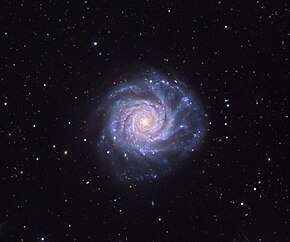| NGC 3938 | |
|---|---|
 | |
| Observation data (J2000 epoch) | |
| Constellation | Ursa Major[1] |
| Right ascension | 11h 52m 42.9s[1] |
| Declination | +44° 07′ 17″[1] |
| Distance | 43 Mly |
| Apparent magnitude (V) | 10.9[1] |
| Characteristics | |
| Type | SA(s)c[2] |
| Apparent size (V) | 5.4′ × 4.9′[1] |
| Other designations | |
| UGC 6856, MCG +07-25-001, PGC 37229[2] | |
Preview warning: Page using Template:Infobox galaxy with unknown parameter "1 = caption
"
Preview warning: Page using Template:Infobox galaxy with unknown parameter "image_size"
NGC 3938 is an unbarred spiral galaxy in the Ursa Major constellation. It was discovered on 6 February 1788 by William Herschel. It is one of the brightest spiral galaxies in the Ursa Major South galaxy group and is roughly 67,000 light years in diameter.[3] It is approximately 43 million light years away from Earth.[1] NGC 3938 is classified as type Sc under the Hubble sequence, a loosely wound spiral galaxy with a smaller and dimmer bulge.[4] The spiral arms of the galaxy contain many areas of ionized atomic hydrogen gas, more so towards the center.[5]
- ^ a b c d e f George Normandin (5 May 2005). "Spiral Galaxy NGC 3839". kopernik.org. Retrieved 30 December 2011.
- ^ a b "Results for object NGC 3938 (NGC 3938)". NASA/IPAC Extragalactic Database. California Institute of Technology. Retrieved 28 February 2021.
- ^ "The Ursa Major Groups". Atlas of the Universe. Retrieved 30 December 2011.
- ^ van der Kruit, P.C.; Shostak, G.S. (1982). "Studies of Nearly Face-on Spiral Galaxies" (PDF). Astronomy and Astrophysics. 105: 351–358. Bibcode:1982A&A...105..351V. Retrieved 25 June 2014.
- ^ Jiménez-Vicente, J.; E. Battaner; M. Rozas; H. Castañeda; et al. (1999). "Fabry-Perot observations of the ionized gas in NGC 3938" (PDF). Astronomy and Astrophysics. 342: 417–425. arXiv:astro-ph/9811391. Bibcode:1999A&A...342..417J.